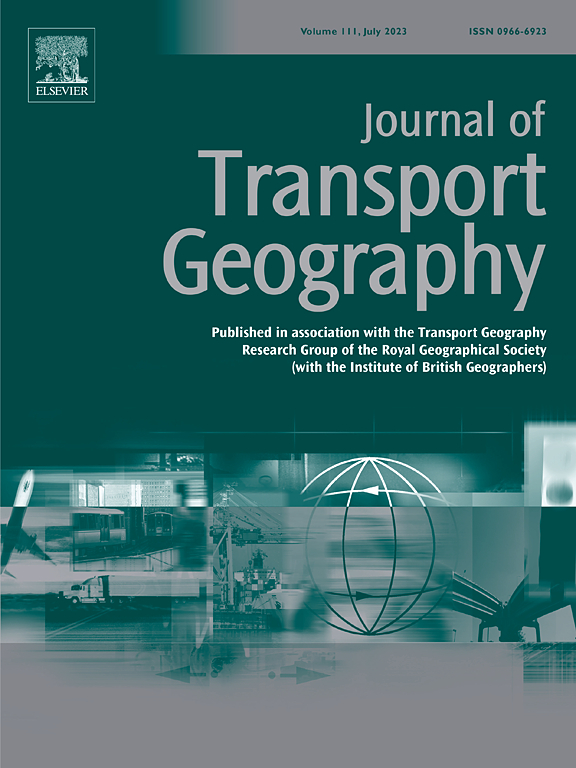流动性的性别差异:使用决策树算法探索多种情境下的非线性关系
IF 6.3
2区 工程技术
Q1 ECONOMICS
引用次数: 0
摘要
随着促进性别平等成为人类的共识,社会流动性中的性别差异及其影响因素已被广泛讨论。现有研究表明,在关键的流动性指标上存在显著的性别差异。然而,大多数讨论仅限于单一或有限的背景或场景,主要集中在变量的线性关系上。此外,大多数研究是在全球北方的大城市进行的,在发展中国家和农村地区留下了研究空白。特别是,强调女性人口,特别是边缘化亚群体内部异质性的调查仍然很少。为了解决这些差距,本研究侧重于不同背景和情景下流动性的性别差异及其影响因素。利用广州市2023 - 2024年的时空活动数据,采用统计分析和决策树算法,识别性别流动的关键指标,并探讨影响因素的非线性效应。研究结果显示,关键的流动性指标存在显著的性别差异。一般来说,女性比男性表现出更频繁的旅行,更小的旅行范围和固定的活动地点。引入不同的上下文和多个场景能够识别更多的细节。此外,研究结果还证实了家庭分工、出行相关恐惧、出行工具获取和个人社会经济地位等因素的非线性影响。对男性和女性的影响是不同的。更重要的是,这些因素的重要性和影响因情景而异。女性人口的内部异质性进一步得到确认,包括低收入、低学历、城郊和城中村妇女在内的边缘化亚群体面临更大的流动性限制。多元语境的分析框架和方法方法也被证明是有效和高效的,为相关研究提供了宝贵的见解。本研究立足于女性主义地理学和时空行为研究,促进了对发展中国家复杂城乡背景下的性别流动差异的理解。研究结果还为减少流动性方面的性别差异和营造更加公平和包容的社会环境提供了政策启示。本文章由计算机程序翻译,如有差异,请以英文原文为准。
Gender differences in mobility: Exploring the non-linear relationship in multiple contexts using decision tree algorithms
As the promotion of gender equality has become the consensus of humanity, gender differences in mobility and its influential factors have been widely discussed. Existing studies have revealed significant gender difference in key mobility indicators. However, most discussions have been limited to single or limited contexts or scenarios and mainly focused on the linear relationships of variables. In addition, most studies were carried out in large cities in the Global North, leaving a research gap in developing countries and rural areas. Particularly, investigations that highlight the heterogeneity within female populations, especially marginalized subgroups, remain scarce. To address these gaps, this study focuses on gender differences in mobility and their influencing factors across diverse contexts and scenarios. Using disaggregated spatiotemporal activity data collected in Guangzhou from 2023 to 2024, we employ statistical analysis and decision tree algorithms to identify key indicators of gendered mobility and explore the non-linear effects of the influential factors. The findings reveal significant gender differences in key mobility indicators. In general, women exhibited more frequent trips, smaller travel ranges, and fixed activity locations than men. The introduction of diverse contexts and multiple scenarios is able to identify more details. In addition, the results confirm nonlinear effects of factors including household division of labor, mobility-related fears, access to mobility tools and personal socioeconomic status. The effects differ between men and women. More importantly, the significance and influence of these factors vary across scenarios. Internal heterogeneity within the female population is further identified, with marginalized subgroup facing greater mobility constraints, including low-income, low-education, suburban, and urban village women residents. The analytical framework of multiple contexts and the methodological approach have also been proven both effective and efficient, offering valuable insights for relevant studies. Grounded in feminist geography and spatiotemporal behavior studies, this research advances the understanding of gendered mobility differences in the complex urban-rural setting in developing countries. Its findings also provide policy implications for reducing gender disparity in mobility and fostering a more equitable and inclusive social environment.
求助全文
通过发布文献求助,成功后即可免费获取论文全文。
去求助
来源期刊

Journal of Transport Geography
Multiple-
CiteScore
11.50
自引率
11.50%
发文量
197
期刊介绍:
A major resurgence has occurred in transport geography in the wake of political and policy changes, huge transport infrastructure projects and responses to urban traffic congestion. The Journal of Transport Geography provides a central focus for developments in this rapidly expanding sub-discipline.
 求助内容:
求助内容: 应助结果提醒方式:
应助结果提醒方式:


